Cadillac ATS and Why Materials Matter
Recently, a friend who writes about cars for a living (he is a bona-fide car reviewer in my estimation, someone who has not only driven all manner of cars in locales all around the world, but who has a love and knowledge of cars such that he even curates exhibitions at art museums of sheet metal and chrome) told me while we were on a drive, “The Cadillac ATS is a really good car.” I responded, “Is it a really good car, or is it a really good Cadillac?” After all, there is a tendency for those of us who have a relationship with American wheels (i.e., we have been born and bred here), regardless of a fondness for Italian prancing horses or Teutonic severity, to want the U.S. companies to be competitive in an arena that they once helped delineate.
Recently, a friend who writes about cars for a living (he is a bona-fide car reviewer in my estimation, someone who has not only driven all manner of cars in locales all around the world, but who has a love and knowledge of cars such that he even curates exhibitions at art museums of sheet metal and chrome) told me while we were on a drive, “The Cadillac ATS is a really good car.”
.jpg;maxWidth=600)
I responded, “Is it a really good car, or is it a really good Cadillac?” After all, there is a tendency for those of us who have a relationship with American wheels (i.e., we have been born and bred here), regardless of a fondness for Italian prancing horses or Teutonic severity, to want the U.S. companies to be competitive in an arena that they once helped delineate. Simply put: we’d be more likely to give it a pass, to make it more than we would something comparable. No one would acknowledge or admit this, but there is it.
He paused, suggested that it was an interesting question, then deliberately answered, “No, the ATS is a good car. If I hadn’t known what it was when I first drove it, I would have been as impressed with it as I am, knowing full well that it is a Cadillac.”
Featured Content
One of the characteristics of the ATS that is remarked upon is that it has been engineered to be light (the base curb weight is as low as 3,315 lb.), which gives rise to spirited, responsive driving.
The Cadillac engineering team who worked on the ATS, under the direction of Dave Leone, went after every gram of weight, looking for the ways and means to take away whatever wasn’t necessary without giving anything up in terms of safety and solidity.
To show some of the materials that they used, the Cadillac team put together this graphic, which is instructive as regards how clever and careful materials use can contribute to the production of “a really good car.” Here it is:



.jpg;width=70;height=70;mode=crop)
















